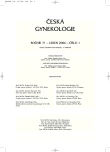Prematurity and Methods of its Screening
Authors:
K. Hurt 1; R. Pruner 2
Authors‘ workplace:
Gynekologicko-porodnická klinika 1. LF UK, Praha, FN na Bulovce, přednosta prof. MUDr. M. Halaška
DrSc.
1; Gynekologicko-porodnická klinika 3. LF UK, Praha, FN KV, přednosta doc. MUDr. B. Svoboda, CSc.
2
Published in:
Ceska Gynekol 2006; 71(1): 3-6
Category:
Original Article
Overview
Objective:
Premature delivery is an essential problem in the modern obstetrics. Revealing and marking the high-risk group of pregnant women in time could be used as one of the methods of its prevention.
Design:
Retrospective epidemiological study of the aggregated data of pregnant patients.
Setting:
OBGYN Clinic of the 1st and 3rd Faculty of Medicine, Prague, FNB, FNKV.
Method:
A routine database of pregnant patients was generated. In our study was included the group of 2368 patients who underwent the screening and fulfilled the condition of completion the data in the period from the 15th to the 20th week of pregnancy, during and after the birth. Database is a component of a lager database generated in the last 15 years. The group of premature delivery patients was marked as those who delivered before the beginning of the 10th month of pregnancy. MS-AFP (maternal serum AFP) screening values of pregnants were measured and transformed to the multiples of medians (MOM), corresponding to the particular week of pregnancy for enabling the comparison during the whole period of screening. Statistical investigation was performed using data analysis advanced methods.
Results:
A significant statistical correlation between higher values of MS-AFP, during the period from the 15th to the 20th week of pregnancy, and premature deliveries were found. The cut-off value of 1.8 MOM MS-AFP was included to determine the higher risk group of patients. Women with equal or higher values of AFP were 3.8 times more likely to have premature delivery than those with lower AFP values (95%CI: 2.2;6.3). Sensitivity of 25% and specificity of 92% were proven.
Conclusion:
According to our opinion, MS-AFP could not only be used for the hereditary diseases screening, but as well for performing the premature delivery screening at the beginning of the 2nd trimester. Cut-off value of 1.8 MOM for marking the higher risk group was used for marking the high-risk group. Thus the extension of the classical screening technique of hereditary diseases could yield also in other areas of the obstetrical care.
Key words:
AFP, prenatal delivery, prematurity, screening, MOM
Labels
Paediatric gynaecology Gynaecology and obstetrics Reproduction medicineArticle was published in
Czech Gynaecology

2006 Issue 1
Most read in this issue
- Prematurity and Methods of its Screening
- Intraductal Papillary Proliferation of Brest. Actual Review and Clinicopathological Corelation
- Ovulatory Mucus and his pH, Arborization and Spermagglutination Antibodies in Women with Fertility Disorders
- Enucleation of Intramural Uterine Fibroids in Women at Fertile Age: Midterm Results of Prospective Clinical Trials
